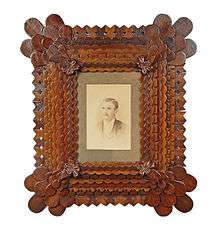Tramp art

Tramp Art was an art movement found throughout the world where small pieces of wood, primarily from discarded cigar boxes and shipping crates, were whittled into layers of geometric shapes having the outside edges of each layer notch carved, or in the technique of a Crown of Thorns. It was popular in the years between the 1870s to the 1940s when the art form started to decline.
The artists used simple tools such as a pocketknife to carve the wood and assemble mostly utilitarian objects. It was made in prodigious numbers around the world but it prospered in the United States. Examples can be found in every state. The most common forms were the box and the frame and although there were no rules or patterns to lend commonality in the artists’ work there were objects made in every conceivable shape and size including full sized furniture and objects of whimsy.
Tramp Art was a democratic art form made wherever the raw materials used in its construction were found. In the United States there were over 50 different ethnic groups documented making it. It appealed to men who might have made an important body of work such as ‘Sunflower’ artist John Martin Zubersky (active c. 1912 – 1920) or the wonderfully expressive wall pockets by John Zadzora (active circa 1910) but also to men who might have made one piece in their lifetime. It was easy to make and appealed to anyone who had a desire to take a pocketknife to wood.
There were countless men, some women, and even children who historically constructed tramp art. Tramp art was mostly made in home based settings and by men who were factory workers, farmers, and labored in just about every conceivable occupation. There were tramps or hoboes who made the art form but not in the numbers the name suggests. The name tramp art was a contemporary invention and had nothing to do with the art form as a whole.
Tramp Art was first discovered in print in 1959 by Francis Lichten in Pennsylvania Folklife, Volume 10 Spring 1959 in which she termed the art ‘Tramp Work.’ In 1975 Helaine Fendelman published the first book on tramp art, Tramp Art an Itinerant's Folk Art. The book acted as a catalog to the first museum show on the art form sponsored by the American Museum of Folk Art.[1]
Bibliography
Books on Tramp Art:
- Helaine Fendelman (1975). Tramp Art, An Itinerant's Folk Art. New York: E. P. Dutton & CO.
- Clifford A Wallach and Michael Cornish (1998). Tramp Art, One Notch at a Time. New York: Wallach-Irons.
- Helaine Fendelman and Jonathan Taylor (1999). Tramp Art A Folk Art Phenomenon. NY: Stewart, Tabori & Chang.
- Clifford A Wallach (2009). Tramp Art Another Notch, Folk Art from the Heart. Atglen, PA: Schiffer Publishing Ltd.
- Clifford A Wallach (2012). A Legacy in Tramp Art. Atglen, Pa: Schiffer Publishing Ltd.
References
- ↑ Clifford A. Wallach. "History of Tramp Art". trampart.com. Retrieved 1 January 2014.